K. Gangadhara Rao1, Edwin Marco Kwesigabo1, B. Basaveswar Rao2, K. Chandan3
1Department of CSE, Acharya Nagarjuna University, Guntur, India
2University Computer Centre, Acharya Nagarjuna University, Guntur, India
3Department of Statistics, Acharya Nagarjuna University, Guntur, India
Correspondence to: Edwin Marco Kwesigabo, Department of CSE, Acharya Nagarjuna University, Guntur, India.
| Email: |  |
Copyright © 2017 Scientific & Academic Publishing. All Rights Reserved.
This work is licensed under the Creative Commons Attribution International License (CC BY).
http://creativecommons.org/licenses/by/4.0/

Abstract
This paper analyses preemptive and non preemptive opportunistic spectrum access of secondary user in cognitive radio network (CRN) using M/D/1 analytical queuing model. Secondary users opportunistically access the spectrum of primary user if the channel is free. For preemptive priority high priority packet preempt a low priority packet and for non preemptive a high priority packet does not preempt a low priority packet instead it waits at head of line (HOL) until channel becomes free. Preempting a Secondary packet and not preempting a secondary packet has effect on packet waiting time and revenue collected from SUs for spectrum sharing. Through spectrum sharing spectrum owner tries to generate more revenue whereas SUs tries to maximize their satisfaction. Numerical illustration is presented using utility function to determine upper and lower boundary of primary arrivals for both preemptive and non preemptive. By using boundaries Optimal secondary packet arrival rates are derived .Analytical results demonstrate that the preemptive priority allow many Secondary packets to be transmitted in short time and in case of non preemptive priority the transmitting secondary packet uses short time but transmitting probability of secondary packet waiting in queue to get a channel becomes very low.
Keywords:
Cognitive radio network, Optimum secondary user, Service rate, Preemptive resume priority, Non preemptive priority, Price and operation cost
Cite this paper: K. Gangadhara Rao, Edwin Marco Kwesigabo, B. Basaveswar Rao, K. Chandan, Analysis of Preemptive Resume Priority and Non Preemptive Priority Access of Secondary Users with Opportunistic Perspective in Cognitive Radio Networks, Journal of Wireless Networking and Communications, Vol. 7 No. 2, 2017, pp. 41-51. doi: 10.5923/j.jwnc.20170702.03.
1. Introduction
In recent years spectrum resources are rapidly becoming scarce due to explosive growth in the number of wireless communication devices using Internet. Most studies shows available spectrum is readily occupied by licensed user. However most of the spectrums are underutilized on time and location due to exclusive usage in dedicated scenarios. CRN has emerged as solution to remedy the current underutilized and inefficient spectrum allocation. CRN is a potential technology used management spectrum as it has capability of sensing, detecting and access the frequency bands which is used and unused. CRN technology allows secondary users (unlicensed user) to use unused bands of primary user (PU) in opportunistic manner to create income to spectrum owner while maximizing the satisfaction levels of unlicensed user. Opportunistic spectrum access priority discipline is categorized into preemptive and non preemptive priority [1]. Under preemptive priority discipline the higher priority user intervene transmission of current service and it transmit immediately once it arrives. Interrupted packet on its re entry may either resume service from the point where it was preempted, or a fresh start over or postponed its preempted service. Non preemptive priority is known as head of the line priority as the higher priority does not interrupt transmitting lower priority instead on its arrival goes to head of the queue and gets service after user receiving service has completed transmission. Under this priority a higher priority user does not intervene with the current service, instead it waits until low priority user finish transmission. In non preemptive priority, low priority users occupying a channel has assurance of being served completely once start transmission as it is not preempted from the channel. Not much work has been done from the perspective of secondary users in the context of CRN especially with related cost analysis.This paper focuses on maximizing SU spectrum utilization using preemptive resume and non preemptive priority. To arrive the desired objective of maximizing spectrum utilization modified M/D/1 queuing model [2] using poison process and common deterministic service rate for both primary and secondary users is used. The objective of this paper is twofold (i) to derive the utility function and finding optimum number of SUs using preemptive and non preemptive priority for given reward, operation cost and service rate. (ii) To derive the optimal number of secondary users for the various values of other operational parameters.The paper is organized as follows, in section II the related work is reviewed, in section III The expression for the utility function is derived, in IV The numerical results is given and finally in section V conclusions are presented.
2. Review of the Literature
Narvada Khedun and Vandana Basssoo [1] have investigated network which consist cognitive radio using M/D/1 priority queuing. Different approaches have applied preemptive and non preemptive priority queuing. They found non preemptive priority queuing improves network transmission for 32% at small arrival rates for the primary user and up 38% for the secondary user and with the preemptive priority, there is 19% - 42% and up to 33% at small arrival rate, reduction in the primary user and secondary user waiting time respectively. Furthermore they used M/D/s model to investigate preemptive and non preemptive priority queuing. The non preemptive model shows decrease in secondary user waiting time, by allowing it to effectively occupy the time slots without affecting the primary user transmission and primary user waiting time is reduced by means of preemptive model. Suliman and J. Lehtomaki [2] performed a theoretical analysis by applying M/D/1 queuing model to analyze the performance of both PUs’ and SUs’ packets in Cognitive Radio Networks. The results are validated with the help of simulation also. Kwesigabo, et al, [3] have investigated opportunistic access of secondary user in cognitive radio network using analytical M/D/1 queuing model. Verified that with the help of spectrum sharing primary user generates revenue and secondary user maximizes its satisfaction with spectrum utilization. Numbers of secondary users and their packet waiting time in the system is calculated. Numerical results are presented using utility function having upper and lower bound of primary arrival. Their result indicates optimal secondary arrival increases and decreases depending on the reward and the state of primary user’s arrivals. Jinyan et al [4] has proposed bargain based cooperation in which licensed and unlicensed user negotiates the duration of cooperation according to the amount of data that licensed user requires. They formulated negotiation process as a bargaining game, and unique Nash equilibrium solution achieved through analytical format. They found bargaining based corporation is efficient and improves the performance of both primary and secondary networks as it reduces a communication interruption. Lichun Wang et al [5] have proposed load balancing multiuser spectrum decision schemes in CRN to distribute traffic loads of secondary user to multiple channels. They used PRP M/G/1 to evaluate effects of multiple interruptions from PU during link connection. They derived the optimal number of candidate channels and the channel optimal selection probability to get overall system time. They found that probability based scheme and sensing based scheme performs better in the case of light and heavy traffic loads respectively. Yun Zhang et al [6] employed PRP M/M/1 queuing model to analyze the transmission delay of priority based secondary users in the opportunistic spectrum access based Cognitive Radio networks. They categorized SUs in to different levels of priority with an assumption that SUs with high priority can access the channel in preference to the SU’s with low priority. They derived an expression for the transmission delay of the interrupted SU’s, which is also based on the M/M/1 queuing model. Their simulation results show that the queuing model with the queuing model with priority based SUs effectively guarantee the quality of service of the high priority level SUs transmission delay of the interrupted SUs. Dafei Sun et al [7] studied tradeoff between spectrum sensing and utilization of spectrum opportunity in Cognitive Radio Network, they formulated tradeoff mathematically and found tradeoff depends on the activity of PU. They studied the cooperative spectrum sensing between PU and SU basing on methodology spectrum utilization. Their numerical analysis quantifies the effects of different parameter on the optimal spectrum sensing time. Mahmoud et al [8] investigated fundamental throughput and delay tradeoffs in cooperative multiple access for cognitive radio system. They have focused on randomized cooperative policies where by SU serves either the queue of its own data or the queue of primary user (PU) relayed data with certain service probabilities. At relying queue they introduced admission control in which PU packet is admitted to the relay queue with admission probability. The proposed relying police introduce a fundamental tradeoff between the delays of PU and SU. They have showed the impact of controlling the flow of data at the relay queue using the admission probability. Results shows that the cooperation expands the stable throughput region.
3. System Model
M/D/1 model is considered in which has perfect transmission (no sensing error and false alarm) and queue length probability generating function for priority queue characterized by packets arrived independently in poison arrivals process and deterministic service time is obtained using supplementary variable method. Packet arrival on the system are patient as once join at the queue they wait until served and they don’t switch between channels. Unlimited queue length is considered and is based on first come first serve. On preemptive the item follows the resume rule so that upon arrival of higher priority, low priority is preempted and upon re entry the service of low priority unit starts at the point of interruption.Non preemptive priority low priority user is not preempted from the channel instead it transmits until completion. Service on non preemptive queue does not involve a delay time of half slot; packet is transmitted depending on user’s priority [1]. Example when PU1 arrive at free channel it start transmission, then SU1, SU2,SU3 can be admitted, when PU1 finish transmission SU1 start transmission but during its transmission PU2 can be admitted since the channel is non preemptive PU2 has higher priority, it waits at the head of the line until SU1 finish transmission.Notations Primary user arrival rate
Primary user arrival rate Secondary user arrival rateμ Service time
Secondary user arrival rateμ Service time Primary average service time
Primary average service time Secondary Average service time
Secondary Average service time Total secondary packet in non preemptive priority
Total secondary packet in non preemptive priority Total secondary packet in preemptive priority
Total secondary packet in preemptive priority Total time spent by secondary user for non preemptive
Total time spent by secondary user for non preemptive  Total time spent by secondary user in preemptive resume
Total time spent by secondary user in preemptive resume Utilization factor for the primary queue
Utilization factor for the primary queue Utilization factor for secondary queue
Utilization factor for secondary queue  Spectrum price for non preemptive priority
Spectrum price for non preemptive priority Spectrum price for preemptive resume priority
Spectrum price for preemptive resume priority Non preemptive priority operation cost
Non preemptive priority operation cost Preemptive resume operation cost
Preemptive resume operation cost Non preemptive priority profit function
Non preemptive priority profit function Preemptive resume priority profit functionThe optimal number of secondary users in non preemptive and preemptive priority is calculated analytically based on the M/D/1 model. Completion time of SU for preemptive and non preemptive priority model is the time of regular customer in system and the time of packets in queue and is calculated as [1] shown below. The service times of PU and SU are same in which
Preemptive resume priority profit functionThe optimal number of secondary users in non preemptive and preemptive priority is calculated analytically based on the M/D/1 model. Completion time of SU for preemptive and non preemptive priority model is the time of regular customer in system and the time of packets in queue and is calculated as [1] shown below. The service times of PU and SU are same in which  and an average service time =
and an average service time =
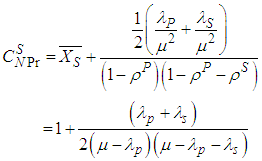 | (1) |
Secondary user non preemptive waiting includes the sum of secondary user service time, the time which primary user spends in queue, the time of secondary packet found in the channel, and the subsequent arrived PU service time.  | (2) |
Preemptive secondary user waiting time includes mean secondary user service time, time which secondary packet spend in a channel after interruption and the subsequent arrival of the PU.Optimal number of Secondary UsersIn this section profit of the PU is used to derive the optimum number of secondary users on the channel for preemptive and non preemptive priority. Profit function for non preemptive priority is reward collected from the secondary user minus the operation cost incurred.  | (3) |
From little’s formula | (4) |
Analysis by obtain optimum number of secondary users is given in index I | (5) |
BoundsFor stability the following must be satisfied.  | (6) |
 Lower bound
Lower bound | (7) |
 | (8) |
 Upper boundPrimary arrival boundaries
Upper boundPrimary arrival boundaries Preemptive Resume PriorityFrom little’s formula the preemptive priority profit function is given as
Preemptive Resume PriorityFrom little’s formula the preemptive priority profit function is given as | (9) |
Analysis of obtaining the optimum number of secondary users is given in Appendix II | (10) |
Boundaries the following must satisfy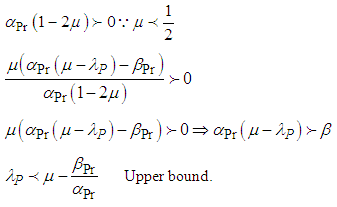
4. Numerical Results
For fixed values of 
 and
and  the computation of
the computation of is as follows.
is as follows. 
 with
with  bounds for non preemptive priority and
bounds for non preemptive priority and  with
with  and
and  for preemptive priority and
for preemptive priority and  for all priorities.Four scenarios considered for both preemptive and non preemptive priority in bounds for1. Variation
for all priorities.Four scenarios considered for both preemptive and non preemptive priority in bounds for1. Variation  2. Variation
2. Variation  3. Variation
3. Variation  4. Variation
4. Variation  Values for non preemptive priorityValues considered is
Values for non preemptive priorityValues considered is  and for lower bound
and for lower bound  when channel is free
when channel is free  , its service time
, its service time  , therefore service time considered
, therefore service time considered  . The bounds for
. The bounds for  is
is 
 inbound values enable to determine
inbound values enable to determine  bound as
bound as ,
,  bound as
bound as  , and
, and  boundary as
boundary as  .
.Values for non preemptive priority
 are calculated in table: 1 below as presented by authors are calculated in table: 1 below as presented by authors
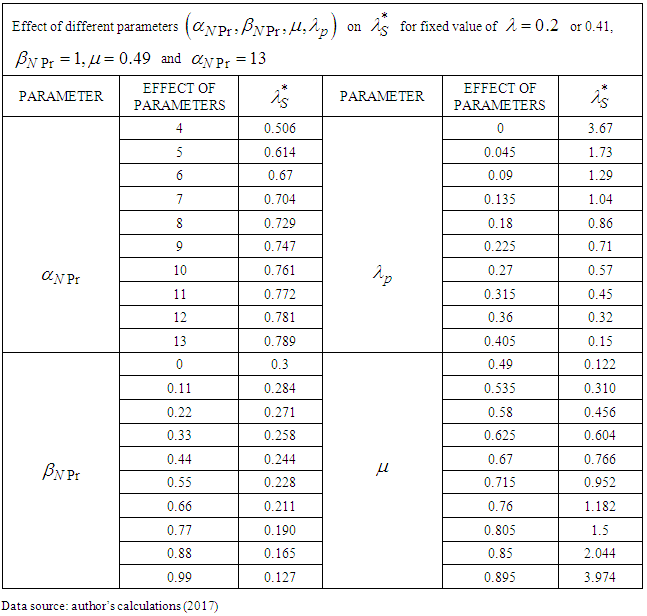 |
| |
|
From figure 1, given  and
and  in table 1 for
in table 1 for  this is minimum spectrum price when
this is minimum spectrum price when  , when
, when is low minimum value of
is low minimum value of  increases and when
increases and when  or
or  increases, minimum values of
increases, minimum values of  decreases. The spectrum owner set minimum price at given
decreases. The spectrum owner set minimum price at given  ,
,  and
and  then allows
then allows  to competes for free spectrum, competition increases
to competes for free spectrum, competition increases  . Competition enables those who pay more to get services in case of spectrum demand is more than size of spectrum available.
. Competition enables those who pay more to get services in case of spectrum demand is more than size of spectrum available.  | Figure 1. Variation in  |
From figure 2, given  ,
,  and
and  in
in  bound when
bound when  approaches lower bound, only small portion of spectrum is occupied by primary user, the remaining portion is free to be shared with secondary user
approaches lower bound, only small portion of spectrum is occupied by primary user, the remaining portion is free to be shared with secondary user  . But when
. But when  approaches upper boundary, big portion is occupied by primary user and only very small portion is free to be shared with secondary user
approaches upper boundary, big portion is occupied by primary user and only very small portion is free to be shared with secondary user  . Therefore increasing
. Therefore increasing  decreases free spectrum which cause
decreases free spectrum which cause  to decrease and vice versa.
to decrease and vice versa.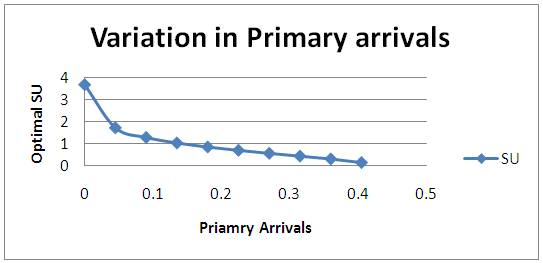 | Figure 2. Variation in  |
From figure 3 below, given  ,
, and
and  in
in  , when
, when  decreases cause maximum
decreases cause maximum  to decreases, while when
to decreases, while when  decreases or
decreases or  increases, maximum
increases, maximum  increases. Maximum
increases. Maximum  enables spectrum owner to determine maximum operation cost according to given
enables spectrum owner to determine maximum operation cost according to given  ,
,  and
and  , depending on these parameters spectrum owner can decide whether to continue with service if is less than maximum operation cost or stop providing services if is more than maximum operation cost. When operation cost is low at constant services time optimal spectrum
, depending on these parameters spectrum owner can decide whether to continue with service if is less than maximum operation cost or stop providing services if is more than maximum operation cost. When operation cost is low at constant services time optimal spectrum  demand is high. Due to user selfish habit when operation cost is high at constant services time, optimal spectrum demand becomes low, as user may not will to pay extra at the same service time but are willing to use more at the same service time when operation cost is low.
demand is high. Due to user selfish habit when operation cost is high at constant services time, optimal spectrum demand becomes low, as user may not will to pay extra at the same service time but are willing to use more at the same service time when operation cost is low.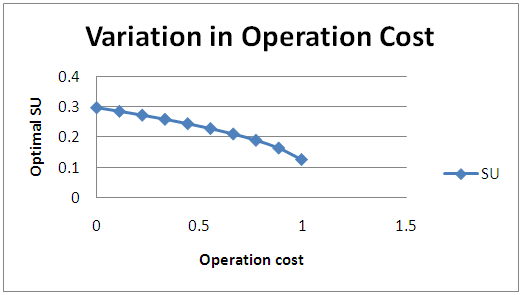 | Figure 3. Variation in  |
From figure 4 below, given  ,
,  and
and  in table 4,
in table 4,  when
when  increases from lower bound,
increases from lower bound,  increases as service time for admitted packet becomes high, packet admitted use short time in the channel, this enables more secondary packet to be admitted and gets services.
increases as service time for admitted packet becomes high, packet admitted use short time in the channel, this enables more secondary packet to be admitted and gets services.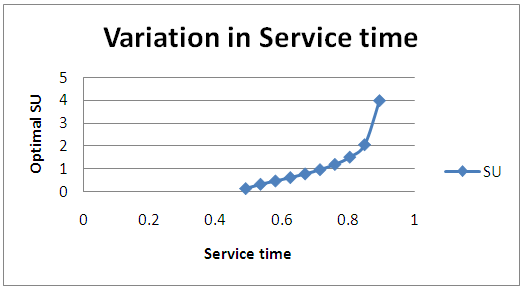 | Figure 4. Variation in  |
Values for Preemptive resume priority
 is calculated in table: 2 below as presented by author’s is calculated in table: 2 below as presented by author’s
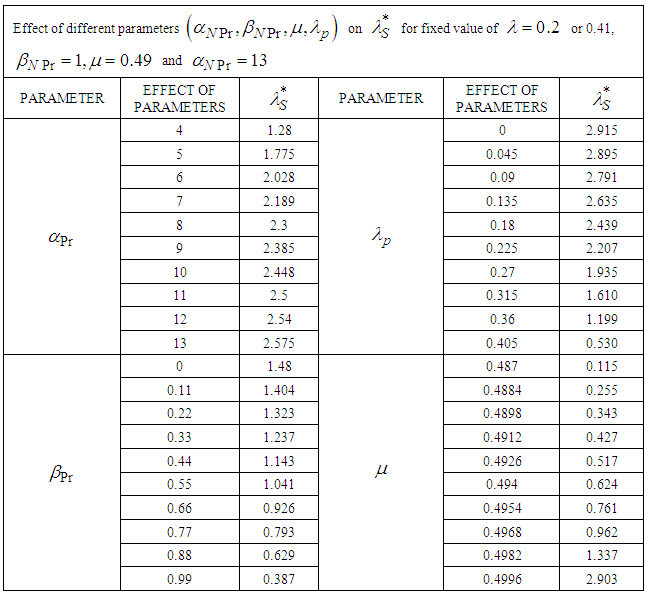 |
| |
|
From figure 5 below, given  ,
,  and
and  , in table 5 minimum bound price is
, in table 5 minimum bound price is  , increasing
, increasing  in preemptive resume priority, optimum
in preemptive resume priority, optimum  increases. Given
increases. Given  , size of free spectrum for
, size of free spectrum for  sharing is known, when the demand of spectrum is greater enough, it enables those who can pay more to get spectrum.
sharing is known, when the demand of spectrum is greater enough, it enables those who can pay more to get spectrum. | Figure 5. Variation in  |
From figure 6 given  ,
,  and
and  in table 6
in table 6  where
where  and
and  when
when  increase decreases free spectrum and
increase decreases free spectrum and  decreases. When
decreases. When  increases, it decreases free spectrum as most it is occupied by licensed user so
increases, it decreases free spectrum as most it is occupied by licensed user so  decreases.
decreases.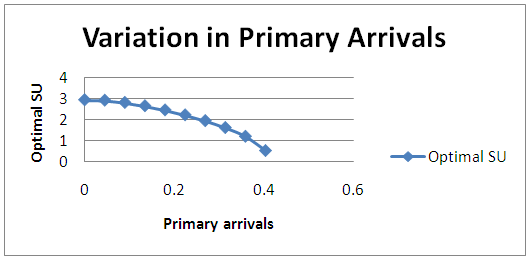 | Figure 6. Variation in  |
From figure 7 given  ,
,  and
and  in table 7 enable to determine maximum bound operation cost
in table 7 enable to determine maximum bound operation cost when
when  is low
is low  is higher, but when
is higher, but when  approaches upper bound
approaches upper bound  becomes very small. Therefore when
becomes very small. Therefore when  increases at given
increases at given  ,
,  and
and  ,
, decreases as user may not will to extra for same service.
decreases as user may not will to extra for same service. | Figure 7. Variation in  |
From figure 8 given  ,
,  and
and  from table 8 in bound
from table 8 in bound  when
when  increases from lower bound
increases from lower bound  increases, when service time increases the admitted
increases, when service time increases the admitted  spends little time in channel which enables more packets to be admitted. So increasing
spends little time in channel which enables more packets to be admitted. So increasing  increases optimal secondary arrivals.
increases optimal secondary arrivals.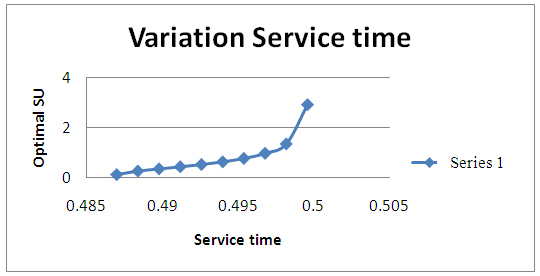 | Figure 8. Variation in  |
Comparison of preemptive resume priority and non pre emptive priorityFrom the table 1 for non preemptive priority and table 2 preemptive resume priority when price increases optimal SU arrival increases for both however optimal secondary arrival are lower than values for preemptive resume (when spectrum price was 4 optimal secondary arrival for non preemptive was 0.506 while for preemptive was 1.279949 and when price was 13 secondary arrival for non preemptive was 0.789 and for preemptive was 2.575.When operation cost increases it slightly decreases optimal secondary arrival for preemptive and non preemptive priority (when there is no operation cost optimal secondary arrival for non preemptive resume is 0.3 and for preemptive was 1.404 and when operation cost is 0.99 for non preemptive 0.127 while for preemptive is 0.387. In non preemptive there is no cooperative between PU and SU, when there is no primary arrival interruption, secondary arrival are higher than preemptive resume priority as they use short time in channel (when there was no primary arrival for non preemptive optimal secondary arrival was 3.67 and for preemptive resume was 2.915 as primary arrival increases since there is no cooperative in non preemptive probability of secondary user to get channel becomes very low and optimal arrivals greatly decreases than preemptive resume priority which has cooperative (when primary arrivals was 0.405 for non preemptive optimal secondary arrival was 0.15 while for preemptive resume 0.53).
5. Conclusions
In this paper, preemptive resume and non preemptive priority using M/D/1 queuing system is used to investigate opportunistic spectrum access method for PU and SU to provide better QoS. Waiting time and queuing time were theoretically derived using modified M/D/1 model. The results show the differences in preemptive and non preemptive priority. Optimal secondary arrival for both increases when price increase but when primary arrival increases optimal secondary arrival for non preemptive greatly decreases than for preemptive resume. These are caused when secondary user occupy the channel it doesn’t preempt on primary arrival, which would also cause more accumulation of primary user waiting for service, when channel becomes available it services only primary arrival and decreases primary user service probability.
Appendix 1
Let 
 Let
Let  and
and 
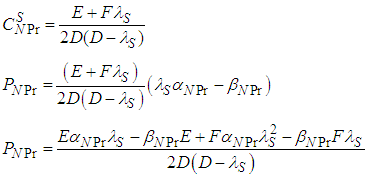 Differentiating profit function against secondary user arrival and equating the value to zero we get optimal secondary arrival
Differentiating profit function against secondary user arrival and equating the value to zero we get optimal secondary arrival
 Quadratic equation to calculate optimum secondary arrival in non preemptive priority
Quadratic equation to calculate optimum secondary arrival in non preemptive priority Substitute the value of E and F
Substitute the value of E and F Substitute D
Substitute D
Appendix 2
 Let
Let 
 Substitute the values of
Substitute the values of 
 We use derivative to find the optimal value of secondary user arrival
We use derivative to find the optimal value of secondary user arrival Expand the equation above and equate to zero
Expand the equation above and equate to zero Use quadratic equation to find optimum secondary arrivals
Use quadratic equation to find optimum secondary arrivals Substitute value E and F
Substitute value E and F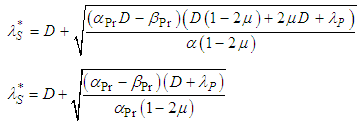 Substitute value D
Substitute value D
References
| [1] | Narvada Khedun and Vandana Bosso, “Analysis of Priority Queueing with Multechannel in cognitive Radio Networks”, IEEE conference paper, 2015, pp 8569 - 8572. |
| [2] | I. Suliman and J. lehtomaki, “Queuing Analysis of Opportunistic Access in Cognitive Radio”, IEEE CogART, 2009, pp. 153 – 157. |
| [3] | Edwin Marco Kwesigabo, K. Gangadhara Rao, B. Basevaswara Rao and K. Chandan, “Access analysis of Secondary with an opportunistic perspective in cognitive Radio Networks” Accepted for publication International Journal of Computation Intelligence Research, 2017. |
| [4] | Jinyan Lu, Rui Wang, Yi Liu and Depei Qian “Throughput maximization with bargaining game in cognitive radio networks” Sino-German Joint Software Institute, In proceeding of the IEEE, 2010, pp 9229-9233. |
| [5] | Li-Chun Wang, Chung-Wei Wang and Fumiyuki Adachi, “Load-Balancing Spectrum Decision for Cognitive Radio Networks”, IEEE Journal on selected areas in communications vol. 29. No. 4, 2011, pp 757 - 759. |
| [6] | Yun Zhang, Tao Jiang, Lei Zhang, Daiming Qu and Wei Peng, “Analysis on the Transmission Delayof Priority – Based Secondary Users in Cognitive radion Networks”, IEEE conference paper, 2013, 978-1-4799-0308-5. |
| [7] | Dafei Sun, Tiecheng Song, Bin Gu, Xi Li, Jing Hu and Miao Lin, “Spectrum sensing and the utilization of spectrum opportunity Tradeoff in Cognitive Radio Networks”, Journal of LATEX CLASS FILES, VOL. 14, 2015. |
| [8] | Mahmoud Ashour, Amr A. El-Sherif, Tamer ElBatt and Amr Mohamed, “Cognitive Radio Networks with Probabilistic Relaying: Stable Throughput and Delay Tradeoffs”, IEEE Transaction on communication, 2014. |



 Primary user arrival rate
Primary user arrival rate Secondary user arrival rateμ Service time
Secondary user arrival rateμ Service time Primary average service time
Primary average service time Secondary Average service time
Secondary Average service time Total secondary packet in non preemptive priority
Total secondary packet in non preemptive priority Total secondary packet in preemptive priority
Total secondary packet in preemptive priority Total time spent by secondary user for non preemptive
Total time spent by secondary user for non preemptive  Total time spent by secondary user in preemptive resume
Total time spent by secondary user in preemptive resume Utilization factor for the primary queue
Utilization factor for the primary queue Utilization factor for secondary queue
Utilization factor for secondary queue  Spectrum price for non preemptive priority
Spectrum price for non preemptive priority Spectrum price for preemptive resume priority
Spectrum price for preemptive resume priority Non preemptive priority operation cost
Non preemptive priority operation cost Preemptive resume operation cost
Preemptive resume operation cost Non preemptive priority profit function
Non preemptive priority profit function Preemptive resume priority profit functionThe optimal number of secondary users in non preemptive and preemptive priority is calculated analytically based on the M/D/1 model. Completion time of SU for preemptive and non preemptive priority model is the time of regular customer in system and the time of packets in queue and is calculated as [1] shown below. The service times of PU and SU are same in which
Preemptive resume priority profit functionThe optimal number of secondary users in non preemptive and preemptive priority is calculated analytically based on the M/D/1 model. Completion time of SU for preemptive and non preemptive priority model is the time of regular customer in system and the time of packets in queue and is calculated as [1] shown below. The service times of PU and SU are same in which  and an average service time =
and an average service time =






 Lower bound
Lower bound

 Upper boundPrimary arrival boundaries
Upper boundPrimary arrival boundaries Preemptive Resume PriorityFrom little’s formula the preemptive priority profit function is given as
Preemptive Resume PriorityFrom little’s formula the preemptive priority profit function is given as



 and
and  the computation of
the computation of is as follows.
is as follows. 
 with
with  bounds for non preemptive priority and
bounds for non preemptive priority and  with
with  and
and  for preemptive priority and
for preemptive priority and  for all priorities.Four scenarios considered for both preemptive and non preemptive priority in bounds for1. Variation
for all priorities.Four scenarios considered for both preemptive and non preemptive priority in bounds for1. Variation  2. Variation
2. Variation  3. Variation
3. Variation  4. Variation
4. Variation  Values for non preemptive priorityValues considered is
Values for non preemptive priorityValues considered is  and for lower bound
and for lower bound  when channel is free
when channel is free  , its service time
, its service time  , therefore service time considered
, therefore service time considered  . The bounds for
. The bounds for  is
is 
 inbound values enable to determine
inbound values enable to determine  bound as
bound as ,
,  bound as
bound as  , and
, and  boundary as
boundary as  .
. and
and  in table 1 for
in table 1 for  this is minimum spectrum price when
this is minimum spectrum price when  , when
, when is low minimum value of
is low minimum value of  increases and when
increases and when  or
or  increases, minimum values of
increases, minimum values of  decreases. The spectrum owner set minimum price at given
decreases. The spectrum owner set minimum price at given  ,
,  and
and  then allows
then allows  to competes for free spectrum, competition increases
to competes for free spectrum, competition increases  . Competition enables those who pay more to get services in case of spectrum demand is more than size of spectrum available.
. Competition enables those who pay more to get services in case of spectrum demand is more than size of spectrum available. 

 ,
,  and
and  in
in  bound when
bound when  approaches lower bound, only small portion of spectrum is occupied by primary user, the remaining portion is free to be shared with secondary user
approaches lower bound, only small portion of spectrum is occupied by primary user, the remaining portion is free to be shared with secondary user  . But when
. But when  approaches upper boundary, big portion is occupied by primary user and only very small portion is free to be shared with secondary user
approaches upper boundary, big portion is occupied by primary user and only very small portion is free to be shared with secondary user  . Therefore increasing
. Therefore increasing  decreases free spectrum which cause
decreases free spectrum which cause  to decrease and vice versa.
to decrease and vice versa.

 ,
, and
and  in
in  , when
, when  decreases cause maximum
decreases cause maximum  to decreases, while when
to decreases, while when  decreases or
decreases or  increases, maximum
increases, maximum  increases. Maximum
increases. Maximum  enables spectrum owner to determine maximum operation cost according to given
enables spectrum owner to determine maximum operation cost according to given  ,
,  and
and  , depending on these parameters spectrum owner can decide whether to continue with service if is less than maximum operation cost or stop providing services if is more than maximum operation cost. When operation cost is low at constant services time optimal spectrum
, depending on these parameters spectrum owner can decide whether to continue with service if is less than maximum operation cost or stop providing services if is more than maximum operation cost. When operation cost is low at constant services time optimal spectrum  demand is high. Due to user selfish habit when operation cost is high at constant services time, optimal spectrum demand becomes low, as user may not will to pay extra at the same service time but are willing to use more at the same service time when operation cost is low.
demand is high. Due to user selfish habit when operation cost is high at constant services time, optimal spectrum demand becomes low, as user may not will to pay extra at the same service time but are willing to use more at the same service time when operation cost is low.

 ,
,  and
and  in table 4,
in table 4,  when
when  increases from lower bound,
increases from lower bound,  increases as service time for admitted packet becomes high, packet admitted use short time in the channel, this enables more secondary packet to be admitted and gets services.
increases as service time for admitted packet becomes high, packet admitted use short time in the channel, this enables more secondary packet to be admitted and gets services.

 ,
,  and
and  , in table 5 minimum bound price is
, in table 5 minimum bound price is  , increasing
, increasing  in preemptive resume priority, optimum
in preemptive resume priority, optimum  increases. Given
increases. Given  , size of free spectrum for
, size of free spectrum for  sharing is known, when the demand of spectrum is greater enough, it enables those who can pay more to get spectrum.
sharing is known, when the demand of spectrum is greater enough, it enables those who can pay more to get spectrum.

 ,
,  and
and  in table 6
in table 6  where
where  and
and  when
when  increase decreases free spectrum and
increase decreases free spectrum and  decreases. When
decreases. When  increases, it decreases free spectrum as most it is occupied by licensed user so
increases, it decreases free spectrum as most it is occupied by licensed user so  decreases.
decreases.

 ,
,  and
and  in table 7 enable to determine maximum bound operation cost
in table 7 enable to determine maximum bound operation cost when
when  is low
is low  is higher, but when
is higher, but when  approaches upper bound
approaches upper bound  becomes very small. Therefore when
becomes very small. Therefore when  increases at given
increases at given  ,
,  and
and  ,
, decreases as user may not will to extra for same service.
decreases as user may not will to extra for same service.

 ,
,  and
and  from table 8 in bound
from table 8 in bound  when
when  increases from lower bound
increases from lower bound  increases, when service time increases the admitted
increases, when service time increases the admitted  spends little time in channel which enables more packets to be admitted. So increasing
spends little time in channel which enables more packets to be admitted. So increasing  increases optimal secondary arrivals.
increases optimal secondary arrivals.


 Let
Let  and
and 
 Differentiating profit function against secondary user arrival and equating the value to zero we get optimal secondary arrival
Differentiating profit function against secondary user arrival and equating the value to zero we get optimal secondary arrival
 Quadratic equation to calculate optimum secondary arrival in non preemptive priority
Quadratic equation to calculate optimum secondary arrival in non preemptive priority Substitute the value of E and F
Substitute the value of E and F Substitute D
Substitute D
 Let
Let 
 Substitute the values of
Substitute the values of 
 We use derivative to find the optimal value of secondary user arrival
We use derivative to find the optimal value of secondary user arrival Expand the equation above and equate to zero
Expand the equation above and equate to zero Use quadratic equation to find optimum secondary arrivals
Use quadratic equation to find optimum secondary arrivals Substitute value E and F
Substitute value E and F Substitute value D
Substitute value D
 Abstract
Abstract Reference
Reference Full-Text PDF
Full-Text PDF Full-text HTML
Full-text HTML are calculated in table: 1 below as presented by authors
are calculated in table: 1 below as presented by authors
 is calculated in table: 2 below as presented by author’s
is calculated in table: 2 below as presented by author’s